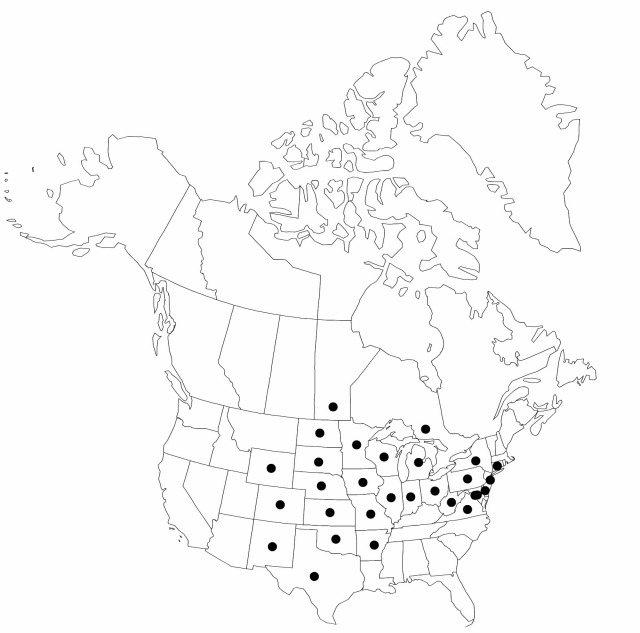Difference between revisions of "Carex emoryi"
in W. H. Emory, Rep. U.S. Mex. Bound. 2(1): 230. 1859.
FNA>Volume Importer |
imported>Volume Importer |
||
| (6 intermediate revisions by 2 users not shown) | |||
| Line 1: | Line 1: | ||
{{Treatment/ID | {{Treatment/ID | ||
|accepted_name=Carex emoryi | |accepted_name=Carex emoryi | ||
| − | |accepted_authority=Dewey | + | |accepted_authority=Dewey |
|publications={{Treatment/Publication | |publications={{Treatment/Publication | ||
|title=in W. H. Emory, Rep. U.S. Mex. Bound. | |title=in W. H. Emory, Rep. U.S. Mex. Bound. | ||
|place=2(1): 230. 1859 | |place=2(1): 230. 1859 | ||
|year=1859 | |year=1859 | ||
| + | }} | ||
| + | |special_status={{Treatment/ID/Special_status | ||
| + | |code=F | ||
| + | |label=Illustrated | ||
}} | }} | ||
|basionyms= | |basionyms= | ||
| Line 11: | Line 15: | ||
|name=Carex millegrana | |name=Carex millegrana | ||
|authority=T. Holm | |authority=T. Holm | ||
| − | }}{{Treatment/ID/Synonym | + | |rank=species |
| + | }} {{Treatment/ID/Synonym | ||
|name=Carex stricta var. elongata | |name=Carex stricta var. elongata | ||
|authority=(Boeckeler) Gleason | |authority=(Boeckeler) Gleason | ||
| − | }}{{Treatment/ID/Synonym | + | |rank=variety |
| + | }} {{Treatment/ID/Synonym | ||
|name=Carex stricta var. emoryi | |name=Carex stricta var. emoryi | ||
|authority=(Dewey) L. H. Bailey | |authority=(Dewey) L. H. Bailey | ||
| − | }}{{Treatment/ID/Synonym | + | |rank=variety |
| + | }} {{Treatment/ID/Synonym | ||
|name=Carex variabilis var. elatior | |name=Carex variabilis var. elatior | ||
|authority=L. H. Bailey | |authority=L. H. Bailey | ||
| − | }}{{Treatment/ID/Synonym | + | |rank=variety |
| + | }} {{Treatment/ID/Synonym | ||
|name=Carex virginiana var. elongata | |name=Carex virginiana var. elongata | ||
|authority=Boeckeler | |authority=Boeckeler | ||
| + | |rank=variety | ||
}} | }} | ||
|hierarchy=Cyperaceae;Carex;Carex sect. Phacocystis;Carex emoryi | |hierarchy=Cyperaceae;Carex;Carex sect. Phacocystis;Carex emoryi | ||
| Line 38: | Line 47: | ||
|elevation=0–1200 m | |elevation=0–1200 m | ||
|distribution=Man.;Ont.;Ark.;Colo.;Conn.;Del.;D.C.;Ill.;Ind.;Iowa;Kans.;Md.;Mich.;Minn.;Mo.;Nebr.;N.J.;N.Mex.;N.Y.;N.Dak.;Ohio;Okla.;Pa.;S.Dak.;Tex.;Va.;W.Va.;Wis.;Wyo.;Mexico (Chihuahua;Coahuila). | |distribution=Man.;Ont.;Ark.;Colo.;Conn.;Del.;D.C.;Ill.;Ind.;Iowa;Kans.;Md.;Mich.;Minn.;Mo.;Nebr.;N.J.;N.Mex.;N.Y.;N.Dak.;Ohio;Okla.;Pa.;S.Dak.;Tex.;Va.;W.Va.;Wis.;Wyo.;Mexico (Chihuahua;Coahuila). | ||
| − | |discussion=<p>Carex emoryi resembles C. aquatilis in size and habit, and has similar sheaths and spike dimensions. It is distinguished by the finely veined perigynia, the prolonged convex sheath apex and truncate ligule, and the hypostomic leaves. Most specimens identified as C. aquatilis var. altior are C. aquatilis; the type of C. aquatilis var. altior is an immature specimen of C. emoryi. Although previously thought to be related to C. stricta, the differences in sheath characters and higher chromosome number suggest that C. emoryi is not a member of the C. stricta subgroup.</p> | + | |discussion=<p><i>Carex emoryi</i> resembles <i>C. aquatilis</i> in size and habit, and has similar sheaths and spike dimensions. It is distinguished by the finely veined perigynia, the prolonged convex sheath apex and truncate ligule, and the hypostomic leaves. Most specimens identified as <i>C. aquatilis</i> var. altior are <i>C. aquatilis</i>; the type of <i>C. aquatilis</i> var. altior is an immature specimen of <i>C. emoryi</i>. Although previously thought to be related to <i>C. stricta</i>, the differences in sheath characters and higher chromosome number suggest that <i>C. emoryi</i> is not a member of the <i>C. stricta</i> subgroup.</p> |
|tables= | |tables= | ||
|references= | |references= | ||
| Line 47: | Line 56: | ||
-->{{#Taxon: | -->{{#Taxon: | ||
name=Carex emoryi | name=Carex emoryi | ||
| − | + | |authority=Dewey | |
| − | |authority=Dewey | ||
|rank=species | |rank=species | ||
|parent rank=section | |parent rank=section | ||
| Line 61: | Line 69: | ||
|publication title=in W. H. Emory, Rep. U.S. Mex. Bound. | |publication title=in W. H. Emory, Rep. U.S. Mex. Bound. | ||
|publication year=1859 | |publication year=1859 | ||
| − | |special status= | + | |special status=Illustrated |
| − | |source xml=https:// | + | |source xml=https://bitbucket.org/aafc-mbb/fna-data-curation/src/2e0870ddd59836b60bcf96646a41e87ea5a5943a/coarse_grained_fna_xml/V23/V23_705.xml |
|genus=Carex | |genus=Carex | ||
|section=Carex sect. Phacocystis | |section=Carex sect. Phacocystis | ||
Latest revision as of 20:42, 5 November 2020
Plants not cespitose. Culms acutely or obtusely angled, 30–115 cm, scabrous. Leaves: basal sheaths red-brown; sheaths of proximal leaves glabrous, fronts lacking spots and veins, apex convex, prolonged; blades 3–6 mm wide. Inflorescences: proximal bract equal to inflorescence, 3–5 mm wide. Spikes erect; proximal 3–5 spikes pistillate, 2.5–10 cm × 3–5 mm, base attenuate; terminal 2–3 spikes staminate. Pistillate scales pale or red-brown, equaling perigynia, apex acute, awnless. Perigynia ascending, green, spots absent, 3–5-veined on each face, somewhat flattened, loosely enclosing achenes, ellipsoid, 1.7–3.2 × 1–2.1 mm, dull, apex rounded or obtuse, papillose; beak 0.1–0.3 mm. Achenes not constricted, dull. 2n = 72.
Phenology: Fruiting May–Jun.
Habitat: Stream banks, ditches, seeps
Elevation: 0–1200 m
Distribution

Man., Ont., Ark., Colo., Conn., Del., D.C., Ill., Ind., Iowa, Kans., Md., Mich., Minn., Mo., Nebr., N.J., N.Mex., N.Y., N.Dak., Ohio, Okla., Pa., S.Dak., Tex., Va., W.Va., Wis., Wyo., Mexico (Chihuahua, Coahuila).
Discussion
Carex emoryi resembles C. aquatilis in size and habit, and has similar sheaths and spike dimensions. It is distinguished by the finely veined perigynia, the prolonged convex sheath apex and truncate ligule, and the hypostomic leaves. Most specimens identified as C. aquatilis var. altior are C. aquatilis; the type of C. aquatilis var. altior is an immature specimen of C. emoryi. Although previously thought to be related to C. stricta, the differences in sheath characters and higher chromosome number suggest that C. emoryi is not a member of the C. stricta subgroup.
Selected References
None.
